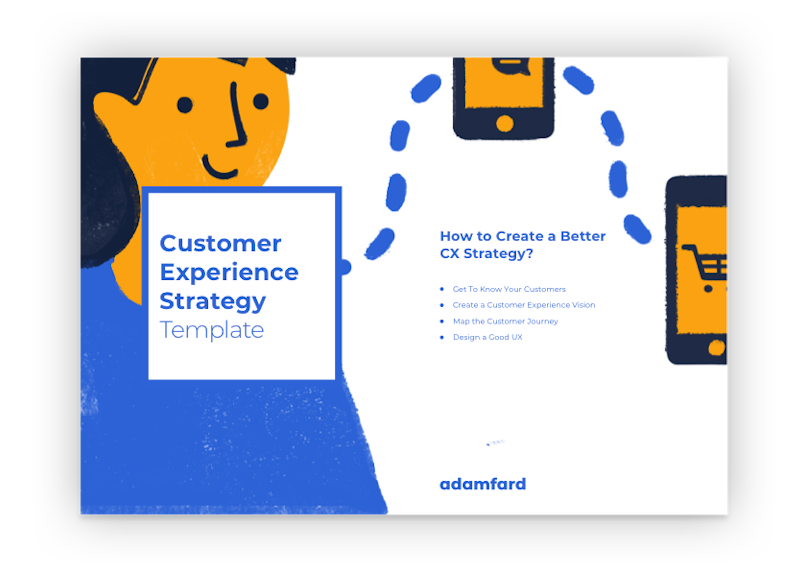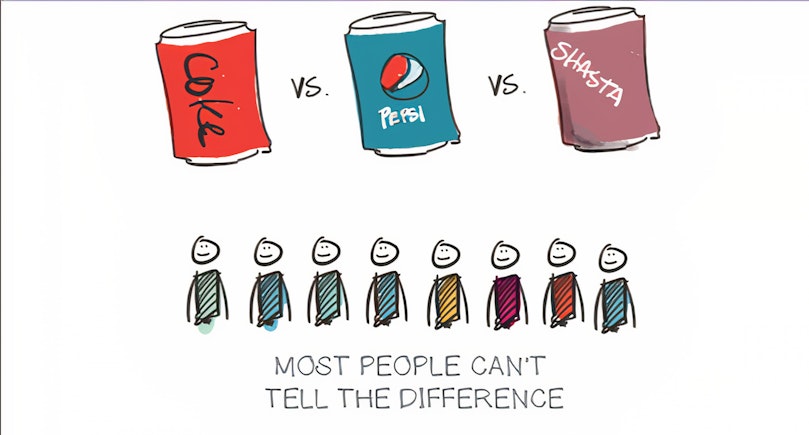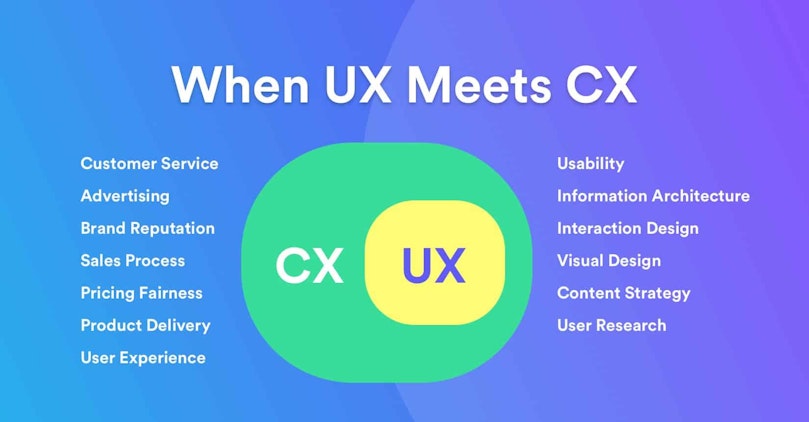Back in the day, companies relied on the quality of their products and word-of-mouth marketing to bring in new customers, but things have changed dramatically in the last few decades.
The mechanics of business-to-customer interaction have become more complex and diverse. What used to be the extra mile ten years ago has become an average feature of a customer’s experience with a product or service.

Ready to create a better customer experience strategy?
You don’t have to do it alone. Download this customer experience strategy template to help you get started:
Download CX TemplateThis ever-evolving landscape underlines the importance of customer experience design. While this discipline’s goal is to increase conversions and the company’s bottom line, it does that by creating fulfilling experiences for a brand’s clientele by leveraging empathy and purpose.
What is CX Design?
Fundamentally, CX design is a discipline that attempts to optimize a consumer’s interaction with a brand. It’s worth mentioning that customer experience doesn’t start when a person begins using a particular product or service—to create a cohesive, recognizable, and enjoyable experience, it’s important to be mindful of how a company interacts with its clientele both before, after, and even during the consumer’s use of the product. The totality of all these interactions is usually referred to as a customer journey map.

Here's an example of a customer journey map.
So it’s fair to say that CX isn’t just a one-time thing. It’s not an ad campaign or a marketing strategy; it’s an attempt to ensure a seamless and meaningful end-to-end experience that will keep customers engaged with a brand.
Plus, it’s worth mentioning that customer experience isn’t an exclusively digital endeavor. A business that commits to improving its customers’ interactions with its brand should also look to make the necessary adjustments to anything from packaging and print-outs to how staff communicates with clientele, or how a manager phones a customer. To achieve this, businesses should leverage data and strong cross-functional collaboration.
So we should think of CX as a means to create near-optimal conditions for your customers that will lead to enjoyable and helpful interactions that will, as a result, lead to their growing satisfaction with your brand.
Why Does CX Matter?
An essential principle of modern branding and CX design is the fact that people want to connect with their favorite brands. Today, it’s fairly common that competing businesses to offer pretty much the same product or service, and their most important differentiator is the experience they provide. Therefore, in order to compete in the modern business ecosystem, companies must commit to crafting experiences that their users resonate with throughout their entire journey.
Having a good product isn't enough. Quality is taken for granted. People don't choose Pepsi or Cola because of their taste. People choose what they choose because of marketing.

Most people can't tell the difference between Coke, Pepsi, or another drink. They're not competing in taste | Screenshot taken from Jason Barron's book The Visual MBA.
As a result of a well-thought-out CX strategy, you’ll see continuously growing customer loyalty and trust, a significant boost in customer satisfaction, and a considerable improvement in word-of-mouth marketing. All of these things will invariably lead to a better bottom line.
And this isn’t just mere speculation—there’s plenty of research to back these claims up. Here are some CX-related stats we think you’ll find useful:
According to a report published by the International Data Corporation, the global CX technology spending is projected to increase to nearly $650 billion by 2022;
A Gartner survey suggests that today two-thirds of companies compete on customer experience, which is over 35% higher compared to 2010;
Almost 90% of companies today have a CXO or similar position, 25% more than in 2017;
A report published by Forrester indicates that three-quarters of interviewed executives consider CX improvement a high or top priority;
What’s in it For You
Now that we’ve covered the basics of what CX is and why it matters, let’s explore some of the benefits that your business will see once it commits to creating meaningful and enjoyable experiences for its customers throughout the entire journey.
Turn New Shoppers into Loyal Customers
We’re all well aware of how complicated, and expensive customer acquisition is. Bringing in a new customer, on average, costs about 7 times more than keeping an existing one.
Fortunately, investing in a high-quality customer experience will not only allow you to significantly decrease your acquisition costs but also help you decrease your customer churn rates. CX is literally an investment in your customers’ satisfaction, and it’s only a matter of time until you see a massive return on that investment.
Enjoy Free Marketing
We’re used to thinking that people are inclined to leave negative reviews more often compared to positive ones. This is no longer the case in the US, at the very least. According to a recent American Express study, US-based consumers, on average, publish more positive reviews. This applies to both social media platforms and reviews sites.
Reviews are a critical part of attracting new customers, as it acts as a form of social proof. This is where CX comes in handy. Providing your existing customers with an impeccable experience will only help stimulate your sales and grow your customer base effortlessly.
See Your Revenue Surge
A study published by Bain & Company suggests that companies that invest resources into their customer experience flows see a considerable boost in their revenue growth, which is between 4-8% higher than the average business.
As niches and industries become oversaturated with competitors, providing your clientele with superior CX can and will act as a defining differentiator. As a result, this will lead you to a higher market share and bottom line.
CX vs. UX
CX and UX are often used interchangeably—this is a mistake. These disciplines have a fair share of similarities, but their differences far outweigh them. Let’s untangle things.
The first and most important thing that needs to be mentioned about the relationship between UX and CX is that they aren’t “related” or “overlapping.” UX is a part of CX.
The same goes for UX and CX designers’ focus points. For instance, a user experience designer will typically focus on a person’s interaction with a product, while a customer experience designer focuses on a person’s experience with the organization itself.
In CX, the customer is typically at the center of attention. One of the central goals of customer experience is to maximize conversions and increase sales. UX, on the other hand, also focuses on the feedback received from users that aren’t necessarily paying customers. Nowadays, CX is more prolific in industries like retail and hospitality since there’s typically a very large number of interactions between a customer and a business in these fields.

CX Design in the Age of AI
Artificial Intelligence (AI) is no longer a futuristic concept; it's a powerful tool reshaping how businesses connect with customers. This technology is transforming the way we think about customer experiences, making interactions more personalized, efficient, and enjoyable. Let's look at the ways AI is improving CX design.
Personalizing Customer Experiences
The best brands are ensuring every customer feels truly understood. AI is making this a reality. By analyzing vast amounts of customer data, businesses can uncover hidden patterns and preferences.
This knowledge helps them to create highly personalized experiences, from product recommendations tailored to individual tastes to marketing messages that resonate on a deeper level. It's about making customers feel special and valued.
Predictive Analytics and Customer Needs Anticipation
AI's ability to predict future trends is another game-changer. Some AI tools can examine past behavior and external factors. Using these tools, businesses can anticipate customer needs before they even arise.
This proactive approach leads to smoother customer journeys and increased satisfaction.
For example, a streaming service might suggest a new show based on your viewing history just as you're about to decide what to watch next.
AI-Powered Chatbots and Virtual Assistants
Gone are the days of long hold times and frustrating customer service interactions. AI-powered chatbots and virtual assistants have completely changed how businesses support their customers.
AI bots can handle routine inquiries, provide information, and even resolve issues quickly and efficiently. This not only improves customer satisfaction but also frees up human agents to focus on more complex problems, creating a better overall customer experience.
Ethical Considerations in AI-Driven CX
While AI offers immense potential for enhancing customer experiences, the ethical landscape is worth careful consideration. While using AI, businesses must ensure:
Data privacy: Protecting customer information is paramount. Businesses must handle personal data responsibly and transparently.
Bias prevention: Ensuring AI algorithms are fair and unbiased helps avoid discriminatory outcomes.
Transparency: Clearly communicating how AI is used builds trust with customers.
Also, considering the potential impact on the human workforce is important for responsible AI adoption. A human-centric AI UX design approach that ensures balancing technology with ethical factors is key to long-term success.
How to Measure the Effectiveness of Your CX?
Knowing how your customers feel about your business is super important. That’s where measuring your Customer Experience (CX) comes in. If you can track the right things and pay attention to what your customers are saying, you will make your business even better.
Key Performance Indicators (KPIs) for CX
So, what should you be tracking? There are many factors you can measure to see how happy your customers are. Here are a few major ones:
Customer Satisfaction: How satisfied are your customers? This is pretty straightforward. You can ask them directly through surveys or feedback forms.
Customer Loyalty: Are your customers loyal to your brand? This is where the Net Promoter Score (NPS) comes in. It helps you figure out how likely customers are to recommend you to their friends.
Customer Effort: How easy is it to do business with you? The Customer Effort Score (CES) tells you how much effort your customers have to put in to get things done.
Repeat Purchases: Do your customers keep coming back? Tracking repeat purchases shows how loyal your customers are.
Churn Rate: Are customers leaving you? Your Churn Rate tells you how many customers are stopping doing business with you.
Data Collection and Analysis for CX Design Improvement
To really understand your customers, you need to gather adequate information from them. This means listening to what they’re saying on social media, through surveys, and when they contact customer support.
Once you have this data, it’s time to dig in and find patterns. What are your customers loving? What’s bugging them? Use this information to improve your business and make your customers happier.
Advanced Analytics for CX Optimization
If you want to get productive with your customer insights, advanced analytics must come into play.
By digging deep into your data, you can uncover hidden treasures that'll help you impress your customers. You will be able to predict what your customers want next or spot problems before they even happen. That's the power of AI.
There are many tools out there to help you do this. Think about using AI platforms that can analyze large amounts of data to discover patterns and those for predictive analytics or machine learning. To learn more about these tools explore our article on AI in business analytics.
With AI analytics, you can turn your data into pure gold for your business. But remember, the goal is to use data to create amazing experiences for your customers.
CX Design Trends
The world of customer experience is always changing. Let’s dive into some of the newest trends shaping how businesses interact with their customers.
Hyper-Personalization and its Benefits
Customers love feeling special. Hyper-personalization is all about delivering tailored experiences that make each customer feel unique. With AI and big data, businesses can create highly customized interactions that resonate with individual preferences.
From personalized product recommendations to targeted marketing messages, hyper-personalization builds stronger customer relationships and drives loyalty.
Creating Seamless Omnichannel Experiences
Today's customers interact with brands across multiple channels— websites, apps, social media, and even physical stores.
To succeed, businesses need to create a seamless experience that spans all these touchpoints. This means ensuring consistency in messaging, branding, and customer service across different channels.
A smooth omnichannel experience makes customers feel valued and connected to your brand.
The Power of Emotional Design in CX
People make many decisions based on emotions. Emotional design focuses on creating experiences that evoke positive feelings. But first, you must understand what makes customers happy, sad, or excited, then you can craft interactions that leave a lasting impression.
Whether it's through storytelling, design, or customer service, emotional connections can build brand loyalty and advocacy.
Staying Ahead of Emerging CX Trends
To keep pace with the fast-evolving CX world, you must stay on top of the latest trends. Keep an eye out for new technologies and how customer needs and behavior is changing. Experiment with emerging areas like augmented reality (AR) and virtual reality (VR) to create amazing experiences.
Don’t be afraid to try something new! Learn from your customers and adapt to their changing needs. And remember, the best way to stay in the know is to follow our blog for the latest CX insights and trends. We'll keep you updated on what's hot and what's not.
Why Empathy is Important in CX Design
In today's business world, empathy is the secret ingredient to building amazing customer experiences. It's about truly understanding your customers and feeling what they feel. When you put yourself in their shoes, you can create solutions that truly solve their problems.
Defining Empathy and its Significance in CX
Empathy means seeing the world through your customer's eyes. It's about understanding their needs, frustrations, and desires. When you have empathy, you can design products and services that actually make a difference in people's lives. It's the foundation for building trust and loyalty.
Building Empathy Within Design Teams
Creating an empathetic culture starts with your team. Encourage everyone to step outside their own experiences and see things from a customer's perspective. Bring customers into your office, conduct interviews, and observe how people use your products.
By immersing yourself in your customers' world, you'll gain valuable insights that can inform your design decisions.
The Link between Empathy and Customer Loyalty
When customers feel understood and valued, they're more likely to become loyal fans of your brand. Empathy builds trust and creates emotional connections. People want to do business with companies that care about them.
Putting yourself in your customers' shoes lets you not only improve their experience but also strengthen your relationship with them.
CX Design Challenges and Solutions
Customer experience isn't a walk in the park. There are challenges along the way, but with the right approach, you can overcome them and create amazing customer experiences. You might struggle with things like:
Getting everyone on board, e.g., your team and stakeholders.
Measuring the success or impact of your CX design strategies.
Keeping up with changing customer expectations.
It's easy to get overwhelmed, but understand that you're not alone. Many businesses face similar challenges. How do they overcome them?
Best Practices For Overcoming CX Obstacles
The good news is that there are things you can do to overcome these hurdles.
Start by setting clear goals and getting buy-in from your entire team. Make sure everyone understands the importance of CX design. Next, use data to track your progress and make adjustments as needed. And most importantly, listen to your customers and act on their feedback.
Finally, to truly succeed at CX design, you need to create a culture where everyone puts the customer first. This means involving employees from all departments in the CX journey. Encourage open communication and collaboration. Celebrate successes and learn from failures.
With a customer-centric culture, you'll create a stronger, more resilient business.
Bottom line
Focusing on your customers’ experience is an extremely efficient way of increasing your business’s bottom line while also keeping your users happy. More importantly, no product or service is excluded here—whatever industry you’re in, whether you’re in the B2B or B2C sector, approaching experience design from an empathetic and thoughtful standpoint will invariably yield great results.





